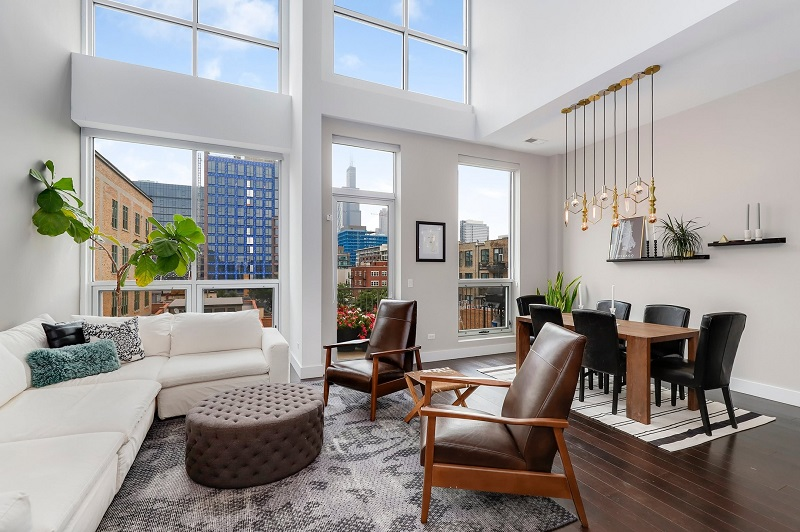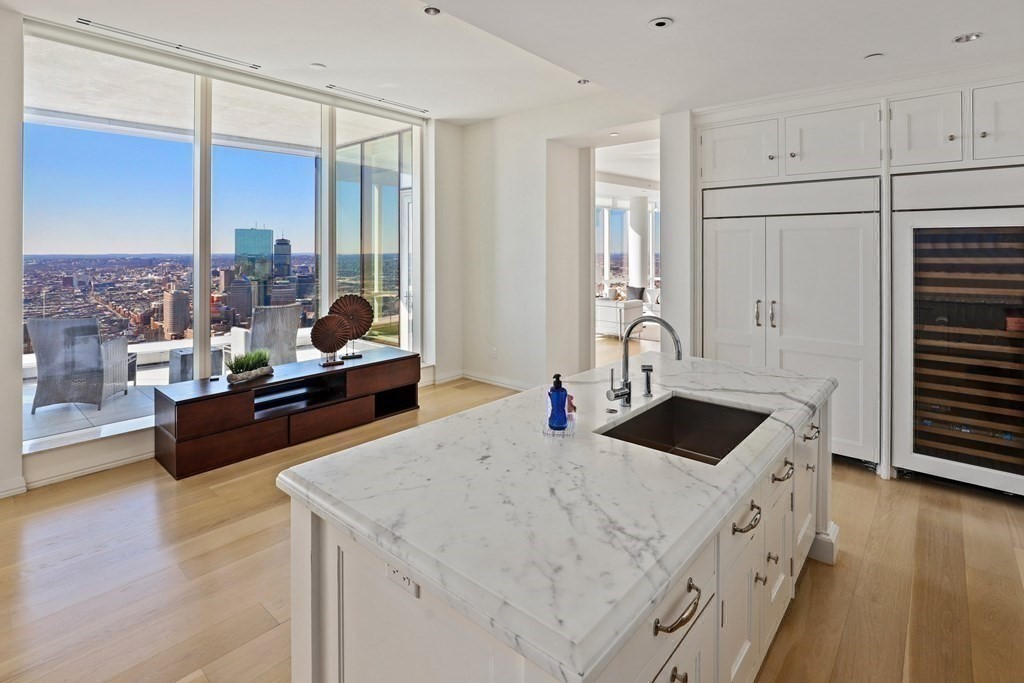Finding the perfect apartment can be overwhelming, especially when there are so many types and styles available to choose from. If you’re searching for a rental in a big city, a high-rise apartment will likely be one of your options. Understanding what a high-rise apartment is will help you decide if this type of apartment is right for you. So whether you’re considering an apartment in Pheonix, New York City, or anywhere in between – let’s break down what a high-rise apartment is, along with the pros and cons, to help you decide if this type of apartment is right for you.
What is a high-rise apartment?
When you hear the term high rise apartment, you might picture tall skyscrapers with more than 40 stories and penthouses with amazing views. In reality, any residential building at least 70-75 feet from ground level is considered a high-rise apartment, with the actual measurement depending on local zoning laws. An easy way to identify a high-rise property in the U.S. is one that has more than seven stories.
High-rise apartment buildings are typically located in major cities. Building up not only allows a developer to create more units to sell, but in large cities, it solves the problem of the shrinking availability of land.

Are high-rise apartments safe?
The technological advancements of the 21st century have improved so many things in our everyday lives, including high-rise apartment buildings. Today’s structures have solid foundations and central cement cores to keep them safe and can withstand strong winds and deflect lightning strikes during thunderstorms.
Safety features to look for
In addition to a well-constructed building, you should also consider looking for these safety features for before signing a lease:
- Fire prevention and safety systems: While fire safety is essential in any residential building, it’s especially vital for high-rise apartments. Well-marked fire alarms, sprinkler systems, and easy-to-access fire extinguishers are all critical features you’ll want to make sure that your building has to keep residents safe and protected.
- Easy to find exits: As you are touring potential apartments, look for clearly marked emergency exit doors that are easily accessible. Emergency situations are stressful enough without wasting critical minutes searching for a way out.
- Reinforced windows: Windows made with solid and sturdy frames, and thick panes of glass are safer and more likely to withstand strong wind gusts. Additionally, look for locking mechanisms that help to prevent dangerous accidents with children and pets.
- High balcony walls or railings: Similar to window locks, high railings with closely spaced slats help prevent falls (and keep items from blowing or falling off).
- Separate elevator banks: To minimize congestion during an emergency or evacuation, high-rise buildings should have multiple banks of elevators that serve different floors. For example, one set would reach floors 1-15; a second set would be for floors 16-30, and so on. Having dedicated elevators for different floors can help residents exit faster.
High-rise vs low-rise apartments, which one is better?
Advantages of living in high-rise apartments
The view: Some might argue that beautiful views are the primary reason for living in high-rise apartments. Unlike a mid-rise or even a low-rise building where your view would likely be another building across from yours, high-rise apartments can put you above most surrounding structures and give you clear, unobstructed views for miles.
Elevators: Unlike most low and many mid-rise buildings, high-rise apartments always have elevators. While you don’t log as many steps, elevators make everything from carrying up your groceries to moving much more manageable than, for example, an apartment building with four floors and no elevator.
Security: The sheer size of most high-rise apartment buildings likely means increased security features. In larger developments, it’s harder to keep track of anyone coming or going; therefore, they often have security cameras. Most have a doorman or a front desk that visitors must pass to access the residences.
Cable and internet ready: The majority of high-rise buildings, especially those built more recently, are pre-wired for cable and internet. It’s easier for a developer to install the infrastructure during construction than for installers trying to run wires up to high floors later. These features mean setting up your service is more convenient and could be less expensive since you won’t have to pay any installation fees.
On-site building management: Have a leaky faucet or broken lock? Living in a high-rise apartment means repair help is only a few floors away. Unlike most low-rise buildings where the landlord is likely offsite, high-rise apartment buildings have on-site maintenance and management staff to handle resident requests.
Location, location, location: For those desiring to live ‘right in the middle of it all,’ a high-rise apartment can be a great choice. Residential buildings with many floors are often found in the center of cities, so you’ll have easy access to work, shopping, dining, and entertainment.
Disadvantages of living in high-rise apartments
- More expensive: The taller the building, the higher the costs to build and maintain it. Apartments in high-rise structures may be priced higher than similar units in lower-rise buildings. Many also have additional monthly maintenance fees to cover security systems, multiple maintenance staff, door attendants, etc.
- Noisy neighbors: While high-rise apartments can help to address housing shortages, that also means that residents have more tenants located all around them. You might live next to someone with lots of visitors or plays loud music. There are steps you can take to soundproof your apartment to help cut down on the extra noise.
- Power outages: Yes, having an elevator is very convenient, but since elevators need power to run, a power outage means you’ll be taking the stairs. The higher you live, the more flights you’ll need to climb. This is less of an issue in low-rise buildings where the number of flights to reach even the top floor is in the single digits.
- Lack of green space: Easy access to outdoor areas is essential for some renters, and high-rise apartments aren’t known for their green spaces. Beyond a balcony and, if you’re lucky, a rooftop deck or garden, getting outdoors means traveling outside to a nearby park or other open areas. Living in a low-rise apartment makes it easy to get out, and many even have small green spaces in the front or back of the building.
- Little to no parking: Even if your building does have parking (and many do not), there are likely only enough available spaces for one car per unit. Finding nearby long-term parking can be a challenge and an extra monthly expense for those with vehicles. Low-rise apartment buildings tend to be located in more residential areas (even within major cities) where parking is often on the street.
- Not always easily accessible: Renters with small children or pets might find high-rise apartment buildings a little more challenging to navigate. Waiting for an available elevator when you’re lugging a bunch of extra baby gear or trying to take your pet out to potty can feel very inconvenient. And for those with health issues that affect mobility, access to an available and working elevator is non-negotiable.

Mid-rise vs high-rise apartments, which one is better?
When deciding between a high-rise or low rise apartment, it ultimately comes down to personal preference. Each has different features, and it’s up to you to weigh out the options and determine which elements are most important to you.
Low and mid-rise apartments have fewer floors and stairs and are therefore easier to navigate. In addition, they have less units in the building, which means fewer neighbors to live with. However, those features might not outweigh the benefits of a high-rise building which can provide peaceful space well above the noisy streets where they are located. Plus, higher-up units can often receive more natural light and clear nighttime skies without the light pollution of headlights, street lamps, and lights from other buildings nearby.
What floor is best to live on in a high-rise apartment?
The choice of floor location is also a personal preference. Each section of a high-rise building has unique benefits and drawbacks that you must evaluate as you consider your options.
Lower floor apartments
Apartments located on the lower floors of a building can provide outdoor spaces such as a private patio, the option to take the stairs vs. waiting for an elevator, and the easier navigation found in low-rise buildings. Additionally, when combined with the amenities of a high-rise, such as enhanced security and on-site maintenance support, many will feel like the lower floor of a high-rise building is the perfect spot for them.
Middle floor apartments
For some renters, a unit on the middle floor of a high-rise building is the best of both worlds. You’ll be high enough that you might have better views and less noise, plus you’ll still find it easy to get outside or carry your clothes down to the laundry room.
Top floor apartments
Having an apartment on a high floor is the main reason some select a high-rise building. These renters value the quiet, natural light, and sweeping views and are happy to trade that for the potential inconvenience that being higher up in a building can cause.

Other considerations before moving into a high-rise apartment
- Moving: Google ‘Is moving stressful?’ and you’ll find endless articles and surveys naming it one of the most stressful events in life. Unfortunately, moving into a high-rise building adds a layer of difficulty. You’re stuck having to rely on elevator access to move in your belongings, and some buildings have restricted hours for activities like moving, which might not ideally align with your schedule.
- Sway: Tall buildings are constructed to withstand high winds, and part of the architecture allows for back-and-forth movement to help with that. For example, Willis Tower in Chicago moves about 3 inches side to side even on a calm day. That said, you still might find that unsettling and determine that a lower-rise building would be a better choice.
- Increased Utilities: The cost to heat and cool apartments on higher floors can be more expensive given the materials they are constructed with and their increased exposure to the elements. You will need to evaluate the increased costs to determine if a high-rise apartment fits within your budget.
Is a high-rise apartment right for you?
Which fits your lifestyle: Fantastic views and less street noise or easier access and better green space? Ultimately it’s up to you to decide which factors rise to the top on your list of apartment must-haves. High-rise living can be an excellent option for many renters, and once you consider all the details, you may find that they are a perfect option for you as well.
The post Pros and Cons of Living in a High-Rise Apartment and What to Consider Before Moving In appeared first on Redfin | Real Estate Tips for Home Buying, Selling & More.
